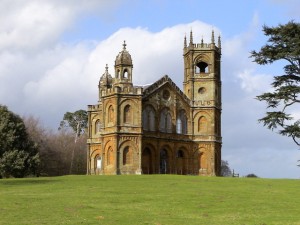CLASS: BONE DEEP GOTHIC
Curious what this is all about? Find out here!

Morris Brownell’s writing suggests that it is difficult to overestimate Alexander Pope’s influence in the enunciation of the picturesque and the development of landscape-style gardening and architecture. However, it also cannot be denied that Pope’s efforts were inspired and modified by a tightly-knit community of ambitious amateur gardeners and professional antiquarians. Landscape gardening, which would evolve alongside and cross-pollinate with the so-called “Gothic Revival,” benefited from a number of innovative practitioners.
One of the earliest and most influential innovators (though not the most famous) was Charles Bridgeman, credited with the invention of the ha-ha. A longstanding problem for English gardeners had been the boundary lines between and within properties, where fences and walls interrupted and marred the continuity of an otherwise “picturesque” perspective. These walls, however, were seen as a practical necessity, so that free-roaming herds of livestock would not wander onto the neighbor’s estate or up near the house. The ha-ha — a ditch sloping down toward a sunken wall — accomplished the same effect as an ordinary wall, but was essentially invisible from a distance.
If Bridgman was revolutionary in his conception of the ha-ha he was a traditionalist in other ways and his designs lean heavily on the French models still popular during his lifetime. More provocative and theatrical ideas found their expression through William Kent. Kent, a contemporary and friend of Pope, also came out of middle-class circumstances, though his genius was more eclectic than literary. A sign and coach painter by trade, Kent distinguished himself sufficiently as a man of taste for his patrons to pay to send him to Italy to study and acquire antiquities. Upon his return to England, he built his reputation not for his comprehensive planning of an estate such as Twickenham, but for his enthusiastic and confident promotion of bold new ideas in architecture and landscape design. Intriguingly, he was not any sort of an expert when it came to horticulture, and rivals sometimes complained that he only used one or two kinds of trees — typically beeches — with which he was most familiar.
Palladianism, Kent’s preferred architectural style, partook of continental aesthetics that looked intentionally to Classical antecedents as opposed to the native Gothic architecture of the Middle-Ages. However, the new landscape designs made even more decisive breaks with continental gardening than did Pope at Twickenham. Gone were the intricate Italian knot motifs and razor-straight French avenues. Instead, designers opted for sinuous paths, expressed a newfound reliance upon trees, and built a succession of architectural novelties.
Today, the shell temples and mock ruins might seem the most dramatic, but at the time it was the use of trees, in particular, that broke with earlier practice and suggested a coming together of seemingly disparate strands. In the Salvatorian ethos (as interpreted by British collectors) trees were ragged and unkempt; a symbol of the untamed wild. To Palladian and picturesque designers, trees evoked a nature that could be both bounteous and temperate. But both perspectives saw, in trees, a canopy, a kind of natural wall and ceiling that contrasted with and lent interest to the Neoclassical aesthetics popular at the time. More, they would recognize, or interpret, in the intertwining boughs of carefully planted trees, the freer, more organic, and yes, explicitly “Gothic” lineation of the medieval High Gothic. The ultimate convergence of the picturesque landscape and the proto-Neo Gothic could be seen in William Kent’s determination to plant a dead tree in Kensington Garden.
It wasn’t, then, incongruous for Alexander Pope to design the gothic Alfred’s Hall Cirencester Park or James Gibbs to design a sham Gothic Temple at the magnificently Palladian Stowe House; like the trees that were given a significance startlingly in contrast with Versailles, these “new” Gothic structures served the dual roles of suggesting a more cooperative relationship with nature as well as promoting British patriotism in the aftermath of the turbulent 17th century. Stowe itself has been often described as the British Versailles, but aside from some superficial similarities in proportion and the approach to the estate, the atmosphere and attitude of each is very different.
Compare, here, a perspective of Versailles today with a view of Stowe House from a similar vantage point. It is also worth pointing out that as late as 1750 — several years after the death of Pope, Kent, and many of their peers — Stowe still betrayed a heavy French influence.
Nevertheless, the styles pioneered by the transitional generation of landscape designers had steered the British style away from continental and strictly Classical symmetries and, importantly for the Gothic, helped cultivate arguments that Medieval inspirations could be as valid as Classical.
